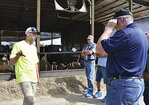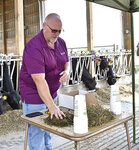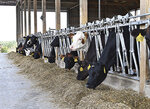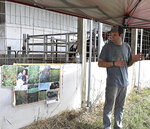ST. AUGUSTA, Minn. – Dan, Tom and Tyler Janski are the fourth generation to farm the diverse landscape of their family’s dairy. Yet, without their curious probe into the use of cover crops on the land, they could have been the last generation to farm.
“We were at the end of a pitiful rope with some of our soils. Some weren’t performing as we would have liked and looked for change,” Dan said. “So, we tried cover crops on a small scale and saw the benefits. It revitalized how we farm.”
Dan and his family – parents Rich and Marlys, and brother Tom – milk 200 cows with four robots on their dairy in Stearns County near St. Augusta. In addition to dairy farming, they grow seven crops: corn, soybean, alfalfa, cereal rye, oat, hemp and canning peas.
In 2016, the Janskis planted a small acreage of cover crops to experiment with a management style that promoted improved soil health and higher quality feeds. Today, the Janskis strictly no till and use cover crops on all of their land, with the exception of the peas which requires some vertical tillage.
“Honestly, at first we were very skeptical with no-till cover crops,” Dan said. “That first year, we took one field that averaged 50 bushels an acre and knifed corn into alfalfa. We got 150-bushel corn that fall.”
The family has also experimented with interseeding a mix of cover crops into both 30-inch and 60-inch corn rows. The forage mix included varieties of clover, vetch, ryegrass and collard.
The 30-inch rows yielded 276 bushels of corn per acre while the 60-inch rows yielded 208 bushels and more soil biomass for a viable option for grazing or added benefits to the corn silage crop. Dan credited the difference in yields to nutrient distribution in the fields.
“Both the 30-inch and 60-inch rows had outstanding forage quality in between the rows, but it was the corn yield that made the difference,” Dan said. “Considering the drought we had last year, I was very happy.”
As the Janskis continue exploring this farm management practice, they have added small grain rotations with their corn and soybean. This reduces tillage and builds organic matter into the soil with a crop that has not yet been incorporated into the land.
While the yields are an obvious benefit to using cover crops, it has been the improved soil makeup that has surprised Dan. The farm is comprised of gravel, sand and clay soils.
When a strong rainstorm dropped 6 inches of rain on the farm this spring, there was only one small field that washed out.
“Aside from a little water that pooled, the ground got every inch of it,” Dan said. “It’s all in the soil.”
However, practicing regenerative agriculture has not come without challenges.
“I like to test and try things. It can be exciting to see the level at which we can do some things,” Dan said. “But, there’s been some successes, and there’s been some struggles.”
This spring, the family planted soybean on a former corn field that was covered with cereal rye over the winter. Unfortunately, about 70% of the field has been damaged by black cutworm.
“I’m not an entomologist,” Dan said. “I’m still learning.”
The cover crops are used as an additional feed source for the Janskis’ livestock. This year, a 10-acre field of chickpeas and barley is being grown as a ground protein source. Their cereal rye crop will be harvested in the fall and cleaned for cover crop seed next season. Other cover crops, if not terminated, are grazed by a small herd of beef or flock of laying hens.
“It’s nice that we can get two crops off a field in a year,” Dan said.
The Janskis work closely with their nutritionist to develop rations for their dairy herd given the crops they produce. In a growing season, the Janskis produce three main forages – haylage, baleage and corn silage.
“This family is on the forefront of technologies and forage quality,” said Dan Rolf of Form-A-Feed. “They grow a lot of feed, and they do a great job.”
Rolf is the Janskis’ nutritionist.
The haylage – a low lignin alfalfa – is harvested with a relative feed value over 200. It is then stored in a bunker and preserved with an inoculant. Baleage is harvested at 175 RFV, baled and wrapped, and preserved with a hay acid. The corn silage is chopped at 60%-65% moisture and stored in a bunker with an inoculant.
Brown midrib corn is not grown so that if the Janskis meet their forage requirements, they can combine the remaining acres for ground corn.
“We try to feed more forages to the cows, and they really do great,” Rolf said.
On a dry matter basis, the lactating ration consists of 35-40 pounds of corn silage, 30-33 pounds of haylage, 8-9 pounds of baleage, 2-3 pounds of dry hay and about 5 pounds of protein concentrates.
“We test our feed every week and adjust as we need to,” Tom said.
During the summer months, the herd is also given an energy booster to maintain milk production through the summer heat.
Dry cows receive a ration of corn silage, grass hay and protein. The heifers are mostly fed refusals from the lactating and dry cow herds with corn silage, grass hay, haylage and a mineral added.
“Our goal is to feed out everything,” Thomas said.
By incorporating the use of no till and cover crops, the Janskis have optimized their land base for growing high-quality feed, and secured another generation’s ability to farm.
“I’m confident in saying that we’re not able to do what we’re doing here without no-till management,” Dan said. “Cover crops have added diversity to the soil and recycle nutrients into the ground, and we’ve seen great results.”




Comments
No comments on this item Please log in to comment by clicking here